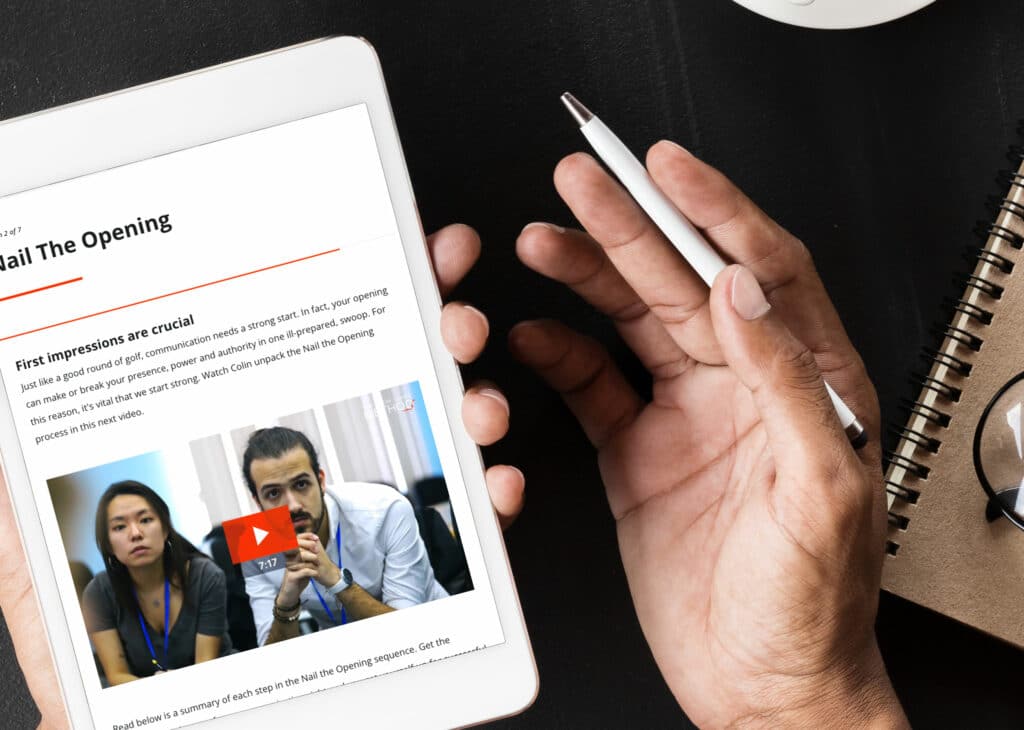Has this ever happened to you? You delivered what you thought was a stirring presentation, with a rousing call-to-action, only to find that people returned to their desks and promptly proceeded to ignore everything you just said. Or you made a request of a colleague, only to find that they ended up doing something completely different to what you asked. If this sounds similar, chances are you’ve suffered from a mismatch of conversational styles.
We all have our conversational quirks and crutches that we rely on, and that’s perfectly fine. The world would be a dull place if we all communicated the same way. But when styles are too misaligned, particularly in the workplace, that can lead to misunderstandings and errors, which can make you appear incompetent or ineffective. Conversely, when styles mesh, you’ll find you can be much more influential and persuasive. All it takes is some clever adjustments on your part to accommodate your audience. In other words, what you need is some adaptive communication skills.
We’ve helped countless professionals take their leadership skills to the next level by teaching them how to read their audience and adapt their communication skills accordingly. Take Kelly Shaw, former Stakeholder Relations and New Business Manager, of AustralianSuper, for example: “Give me a microphone and I’ll chat to you, tell you great stories and be fun and engaging. But I’m not quite sure if I got my point across… Confidence is great, but actual delivery is another thing, and delivery that is powerful, and really communicates the message, is more than just confidence,” she says.
Through the Mastering Communication Program, we were able to give Kelly the tools she needed to ensure she was taking her audience along for the ride: “The program was fantastic; it allowed me to continue building my confidence, continue with my presentation style, but make sure I delivered in a way where I didn’t get lost rambling when telling a great story… I didn’t lose the audience.”
We can help. Starting with this guide to the 4 styles of communication. It will run you through how to adapt your communication style to get a better outcome with your audience.
4 styles of communication
A person’s personality heavily influences the way in which they communicate, so by noticing certain traits, you can identify their communication style and adjust your own style accordingly.
There are 4 common communication styles: analytical, intuitive, functional and personal. It’s important to remember that most people won’t fit neatly into one of these boxes – they are unique snowflakes, and therefore tend to have a mix of communication styles. That being said, they will usually have one style that is particularly dominant.
Every style has its pros and cons, and some may even conflict directly with each other. (If you’re not sure which is your dominant style, check out this quiz.)
Analytical Communicator
The Analytical Communicator is a numbers person. They don’t want to just hear that conversion rates on your sales activities are up – they want an exact percentage and a sexy graph that plots the exact performance of these activities over the past few months.
They tend to have little patience with flowery or emotional language, and small talk – they want you to get to the point, give them the facts and fast.
On the plus side, because they are so logical and systematic, they are seen as highly competent and are often looked to for their objective views and finesse with data-handling and number-crunching.
However, they can be perceived as cold and unfeeling, which could make it difficult for them to connect with employees.
If this is who you’re communicating with, adapt your communication style and:
- Give them the facts, organised in a logical manner, as quickly as possible
- Give them time to get across the data before expecting a decision
Don’t
- Use emotional expressions, like “I feel…”, or “I sense that…”
- Take it personally or get offended when they don’t want to spend time chatting about what they did on the weekend
Intuitive Communicator
Intuitive Communicators are less about the numbers and more about the feel of the big picture. They don’t want to get bogged down in the details – just give them the highlight reel, with the overarching purpose. What are you trying to achieve as a result of this initiative? They love nothing more than to take an idea and run with it, and they have absolutely no problem with pushing boundaries and challenging convention. If they don’t have a good feel for it though, they will procrastinate and stall.
On the plus side, this makes them highly innovative, quick on their feet, and able to take on creative and ambitious projects with gusto.
The downside, however, is they tend to be impatient in those situations where the nitty-gritty details are actually pretty important. They can, therefore, tend to butt heads with Functional Communicators the most – though, when these two learn how to communicate effectively, it’s a match made in heaven.
If this is who you’re communicating with, adapt your communication style and:
- Cut to the chase right away and tell them the purpose of the project
- Give them a broad overview, and skip to the end
- Be prepared for a quick decision
Don’t
- Start with small talk
- Go into intimate detail or give them a blow-by-blow account (but be prepared to answer any follow-up questions)
- Take it personally or be offended if their response is blunt
Personal Communicator
The Personal Communicator is a people person. Their goal is to connect with people, and understand how they’re feeling – they’re the ones who are always smoothing over workplace disagreements or ensuring people have cake on their birthdays. They tend to use more emotional language at work; you’ll hear them saying things like, “I feel really good about this new direction for us.”
On the upside, Personal Communicators are very approachable, and they tend to pick up on subtle emotional cues others might miss, which makes them adept at identifying and addressing problems quickly. They’re excellent peacemakers and are often seen as the “glue” that holds a team together.
On the downside, however, they can be seen as too “touchy-feely” by their colleagues and easily distracted from a task, particularly by Analytical Communicators, who can upset Personal Communicators with their bluntness.
If this is who you’re communicating with, adapt your communication style and:
- Be casual in your approach – small talk is welcome here!
- Expect them to be a little too optimistic about what they and the people around them are capable of
- Email the pertinent details of the conversation to them afterwards, so they can refer to it
Don’t
- Be afraid to use humour
- Be curt or short
- Restrain them from expressing their emotions and ideas
Functional Communicator
The Functional Communicator loves nothing more than a well-thought-out, meticulous plan, process or timeline. Their folders are filled with highly detailed spreadsheets, which they refer to regularly. When they communicate, they tend to do so very methodically, going through every step so that nothing is missed.
On the plus side, their methodical nature means they rarely overlook a detail or miss a deadline. As such, they are often looked to when it comes to implementation, as people know that they will do things properly.
On the downside, their insistence on going through every little step of every little process when communicating can be off-putting to their colleagues, particularly Intuitive Communicators. They also don’t tend to deal well with things going off book, and find it very hard to “go with the flow”.
If this is who you’re communicating with, adapt your communication style and:
- Be methodical in how you present your information
- Get into the nitty-gritty details
- Give them lots of time to make decisions
Don’t
- Give broad overviews, or skip to the end – they hate that!
- Come to a meeting with them unprepared
Know your audience
All of this is really to say, “Know your audience” – something we advocate and cover at great length in the Mastering Communication program.
“Using the principles of what’s in it for the audience, starting with the why and really understanding the key points I want to get across helped me stay on focus throughout the presentation,” says Kelly. “It also helped the audience understand where I was going.”
If you want to be able to influence and persuade your audience, and have them eating out of the palm of your hand, just like Kelly, then sign up for the next Mastering Communication Program. As Kelly says, “This is a really important course if you want to make sure you’re getting your point across. It’s as simple as that.”
Don’t miss out on a spot – register today!
The Colin James Method® Facilitators train corporate executives to improve their professional development with a proven methodology. Our highly trained Facilitators and Coaches are recognised for their experience in their fields and have worked with many individuals and organisations around the world to master the art of communication.











